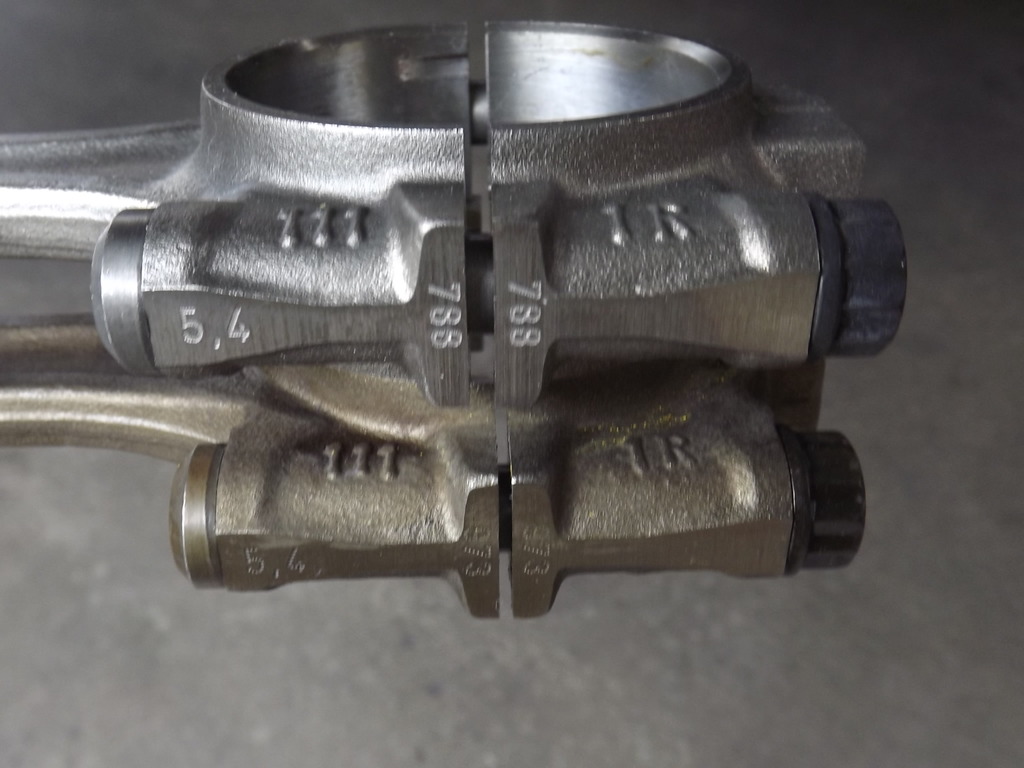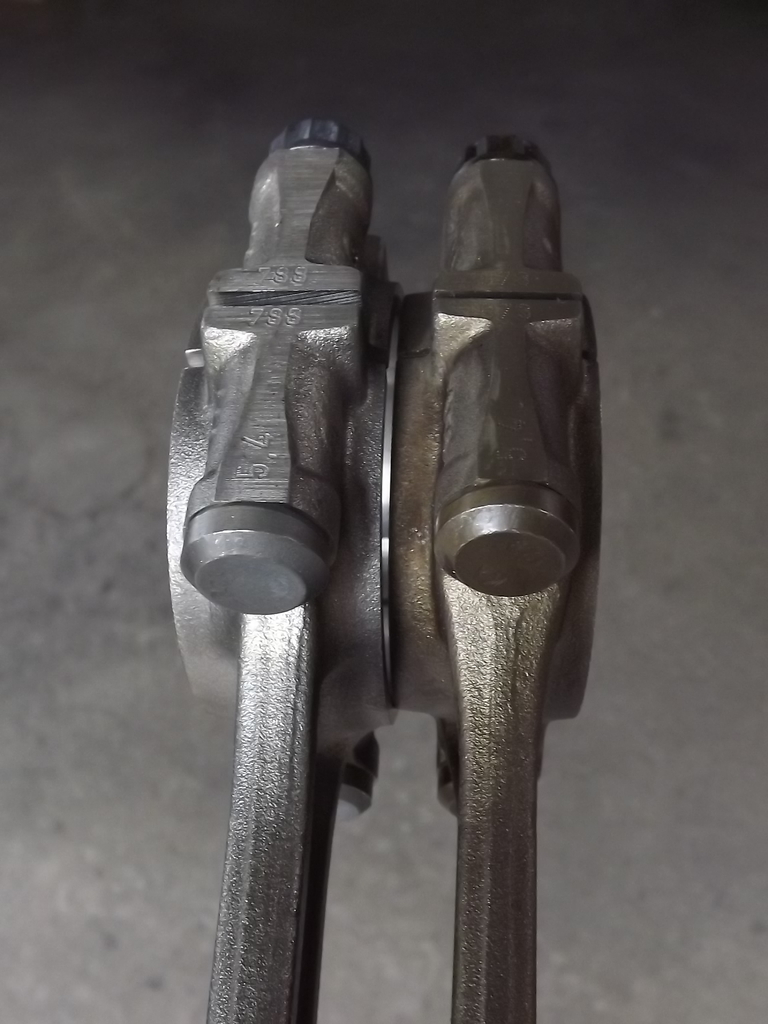GTS connecting rods...interesting data point
#1
Former Vendor
Thread Starter
In technical bulletin #9401, regarding the reinforced GTS connecting rods, it is stated that the early production 2R rods still had the "1R" casting number...and here's proof.
Both castings "1R":

One rod early style, one rod late style:

Before anyone condemns your GTS connecting rods as being early 1R rods and tells you that you need to buy the 2R rods, make sure that they have measured the rods and that they are not the later rod with the 1R casting.
Both castings "1R":

One rod early style, one rod late style:

Before anyone condemns your GTS connecting rods as being early 1R rods and tells you that you need to buy the 2R rods, make sure that they have measured the rods and that they are not the later rod with the 1R casting.
#2
Thanks for this tidbit Greg.
#3
Burning Brakes
very interesting seeing the difference between the R1 and the R2 rods and how they increased material on the transition from shank to big end . Porsche must have had some failures at some point . Are they cast or forged ? Perhaps they just modified the R1 dies at first , and then updated the numbers on a later set of dies
#4
Rennlist Member
We know that the 1R rods were superceded by the 2R rods that are stronger but have you [or anyone else for that matter] actually seen an engine fail because the 1R rod was simply inadequate?
Rgds
Fred
#5
Rennlist Member
Join Date: Aug 2014
Location: Adirondack Mountains, New York
Posts: 2,420
Received 318 Likes
on
166 Posts
I just read somewhere - the development "big book"? - that they were forged from powder metallurgy blanks. High class stuff.
That is, guessing at the details, a crucible of molten steel was poured into a nozzle with jets of argon, atomizing the liquid into powder. The powder was pressed into over-sized blanks on equipment resembling pill-making machines. The blank was sintered in a vacuum, or hydrogen, or fuel gas kept to a certain carbon potential - controlling carbon is key.
A part at this point can be better than a casting, but not as good as a forging. One or a few coining operations makes it as good as a forging, or better since there can be no defect larger than the powder particle size - providing extreme cleanliness has been used.
(BS alert: This was not my particular area of expertise, and there are many variations on this theme.)
Edit: The first thought in the factory when needing to modify a part will be "can we re-work the dies?" Dies are expensive. It's easy to make a part bigger in a few areas with a little grinding on the dies.
That is, guessing at the details, a crucible of molten steel was poured into a nozzle with jets of argon, atomizing the liquid into powder. The powder was pressed into over-sized blanks on equipment resembling pill-making machines. The blank was sintered in a vacuum, or hydrogen, or fuel gas kept to a certain carbon potential - controlling carbon is key.
A part at this point can be better than a casting, but not as good as a forging. One or a few coining operations makes it as good as a forging, or better since there can be no defect larger than the powder particle size - providing extreme cleanliness has been used.
(BS alert: This was not my particular area of expertise, and there are many variations on this theme.)
Edit: The first thought in the factory when needing to modify a part will be "can we re-work the dies?" Dies are expensive. It's easy to make a part bigger in a few areas with a little grinding on the dies.
#6
Nordschleife Master
Is it possible that they used the rod end caps from the previous 1R batch to save money? These rods were not powder forged and cracked, so I think (but do not know) that, before machining the big end, the end caps are interchangeable. Now don't take that as a fact, it's pure speculation and a theory, easily proven to be incorrect if also the beam of the rod has 1R marking.
#7
Nordschleife Master
I think (but do not know) that the GTS rods are "conventionally" forged, because they needed lighter rods for the longer stroke without having to model the whole engine again. At the time, before they started cracking the PPF rods, making a conrod of the required weight and strength was cheapest with conventional forging. Goes without saying, this is speculation, other than the GTS rods being conventionally forged.
928 rods before about 1988 were PPF rods. Between 1988 (or about there) and GTS 5.4 engine they were cast.
928 rods before about 1988 were PPF rods. Between 1988 (or about there) and GTS 5.4 engine they were cast.
I just read somewhere - the development "big book"? - that they were forged from powder metallurgy blanks. High class stuff.
That is, guessing at the details, a crucible of molten steel was poured into a nozzle with jets of argon, atomizing the liquid into powder. The powder was pressed into over-sized blanks on equipment resembling pill-making machines. The blank was sintered in a vacuum, or hydrogen, or fuel gas kept to a certain carbon potential - controlling carbon is key.
A part at this point can be better than a casting, but not as good as a forging. One or a few coining operations makes it as good as a forging, or better since there can be no defect larger than the powder particle size - providing extreme cleanliness has been used.
(BS alert: This was not my particular area of expertise, and there are many variations on this theme.)
That is, guessing at the details, a crucible of molten steel was poured into a nozzle with jets of argon, atomizing the liquid into powder. The powder was pressed into over-sized blanks on equipment resembling pill-making machines. The blank was sintered in a vacuum, or hydrogen, or fuel gas kept to a certain carbon potential - controlling carbon is key.
A part at this point can be better than a casting, but not as good as a forging. One or a few coining operations makes it as good as a forging, or better since there can be no defect larger than the powder particle size - providing extreme cleanliness has been used.
(BS alert: This was not my particular area of expertise, and there are many variations on this theme.)
Trending Topics
#8
Former Vendor
Thread Starter
very interesting seeing the difference between the R1 and the R2 rods and how they increased material on the transition from shank to big end . Porsche must have had some failures at some point . Are they cast or forged ? Perhaps they just modified the R1 dies at first , and then updated the numbers on a later set of dies
#9
Former Vendor
Thread Starter
I just read somewhere - the development "big book"? - that they were forged from powder metallurgy blanks. High class stuff.
That is, guessing at the details, a crucible of molten steel was poured into a nozzle with jets of argon, atomizing the liquid into powder. The powder was pressed into over-sized blanks on equipment resembling pill-making machines. The blank was sintered in a vacuum, or hydrogen, or fuel gas kept to a certain carbon potential - controlling carbon is key.
A part at this point can be better than a casting, but not as good as a forging. One or a few coining operations makes it as good as a forging, or better since there can be no defect larger than the powder particle size - providing extreme cleanliness has been used.
(BS alert: This was not my particular area of expertise, and there are many variations on this theme.)
Edit: The first thought in the factory when needing to modify a part will be "can we re-work the dies?" Dies are expensive. It's easy to make a part bigger in a few areas with a little grinding on the dies.
That is, guessing at the details, a crucible of molten steel was poured into a nozzle with jets of argon, atomizing the liquid into powder. The powder was pressed into over-sized blanks on equipment resembling pill-making machines. The blank was sintered in a vacuum, or hydrogen, or fuel gas kept to a certain carbon potential - controlling carbon is key.
A part at this point can be better than a casting, but not as good as a forging. One or a few coining operations makes it as good as a forging, or better since there can be no defect larger than the powder particle size - providing extreme cleanliness has been used.
(BS alert: This was not my particular area of expertise, and there are many variations on this theme.)
Edit: The first thought in the factory when needing to modify a part will be "can we re-work the dies?" Dies are expensive. It's easy to make a part bigger in a few areas with a little grinding on the dies.
The GT engines got a different rod and the GTS engine got two different (minor changes) rods.
#10
Former Vendor
Thread Starter
If you read the technical bulletin on the "updated" GTS connecting rods, it's not subtle. This is pretty strong language, for the Germans. They, obviously, saw problems.
I have and continuse to use the "early" rods in rebuilts....kicking and screaming all the way....but whatever the client wants.
#11
Rennlist Member
I've seen one broken rod.
If you read the technical bulletin on the "updated" GTS connecting rods, it's not subtle. This is pretty strong language, for the Germans. They, obviously, saw problems.
I have and continuse to use the "early" rods in rebuilts....kicking and screaming all the way....but whatever the client wants.
If you read the technical bulletin on the "updated" GTS connecting rods, it's not subtle. This is pretty strong language, for the Germans. They, obviously, saw problems.
I have and continuse to use the "early" rods in rebuilts....kicking and screaming all the way....but whatever the client wants.
Rgds
Fred
#12
Former Vendor
Thread Starter
i have a set of these and pistons from the original GTS motor that TBF'd before I acquired this one. I would not want to touch my S4 motor but if I was able to pick up another S4 or GTS block it would be nice to build a GTS spec motor given I also have heads, S3 cam set etc.
Rgds
Fred
Rgds
Fred
At this point in time, the difficulty in finding a used GTS crankcase, makes anyone considering using the "early rod" inside one of these engines.....incredibly naive.
Most of the pistons that were in engines with TBF are junk, from the debris and side loading.
I would not re-use an "early design" rod from an engine with TBF....most of them were subjected to crazy side loading....and clearly the early design had issues right where the beam joins the lower cap area.....and this would be made worse with any sort of side loading.


